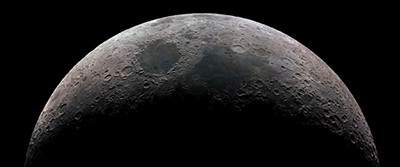Moon Craters Shed Light on Asteroid Impacts on Earth

By Gina Wynn
In a recent study of the craters on the moon’s surface, scientists gained some insights into the Earth’s 4.5-billion-year history.
Planetary scientist Rebecca Ghent at the University of Toronto and graduate student Sara Mazrouei examined the surface of the moon to find out about the Earth’s craters. Because the moon is fairly close to Earth, they argued that both entities would have endured the same asteroid storms and impacts that left gigantic scars.
They chose to gather information about craters on the moon because, unlike the Earth, the moon doesn’t have an atmosphere or plate tectonics. Evidence of what happened to the moon since its formation has been preserved.
Geologists originally thought erosion would have erased evidence of the Earth’s craters long ago.
But the team’s research showed many of Earth’s craters actually withstood the test of time. After mapping and charting the ages and sizes of moon craters, they found that 38 of the Earth’s largest craters had similar characteristics.
Making a Map
To plot the dates of the craters, Ghent started with the youngest ones on the moon. In 2014, she realized the craters were surrounded by large rocks dislodged by the asteroids when they struck the moon to form the craters. These rocks are easy to spot because they emit light during the lunar night from the sun’s heat they absorbed during the day.
The Lunar Reconnaissance Orbiter (LRO) has been gathering data of the lit-up areas to help planetary scientists map the crater debris. LRO is a robotic mission set in orbit by the National Aeronautics and Space Administration (NASA) in 2009 to map the moon's surface.
“Right away you could see the young craters popping out,” Ghent said. The older craters didn’t glow as brightly because the rocks had broken down over time.
By developing a mathematical relationship between the ages of older known lunar craters and the nighttime glow of newly identified craters, Ghent was able to determine the ages of the newer craters. Mazrouei then mapped the 111 craters that are less than a billion years old and larger than 10 kilometers in diameter and used that data to determine the cratering rate.
New Knowledge
What Ghent and Mazrouei found contradicted the belief held by many lunar scientists that the rate of impact to the moon had been mostly constant since a turbulent period more than 3 billion years ago. Mazrouei’s mapping showed the rate wasn’t constant. They discovered a rise in impacts by a factor of 2.6 around 290 million years ago.
Some scientists think this spike may be linked to the asteroid strike that killed the dinosaurs. But Ghent hesitates to put an exact date on the period of increased impacts. Estimates could vary by tens of millions of years or the events could have occurred in multiple spurts.
An Alternative Explanation
According to study co-author William Bottke, planetary scientist at the Southwest Research Institute in Boulder, CO, this new research could explain why we see fewer craters on Earth that are between 300 million and 650 million years old.
“We don’t see fewer craters because of erosion,” Bottke said. “We see fewer craters because the impact flux was lower.”
As for craters that are older than 650 million years, Bottke thinks they could have been scraped away during global glacial periods like the one called Snowball Earth.
Although planetary scientists have differing opinions on the University of Toronto study because of the low number of craters involved in the calculations, most would agree that it’s worth taking note of the research methodology. If other researchers are able to reproduce the team’s methods on a larger scale, they will likely play a major role in advancing scientists’ understanding of impact fluctuations within our solar system.
Discussion Questions
- Why can we learn things about the Earth by studying the moon?
- Why do scientists think it’s important to learn about asteroids impacting the Earth millions of years ago?
Vocabulary
- Asteroids
- Atmosphere
- Lunar
- Plate Tectonics

